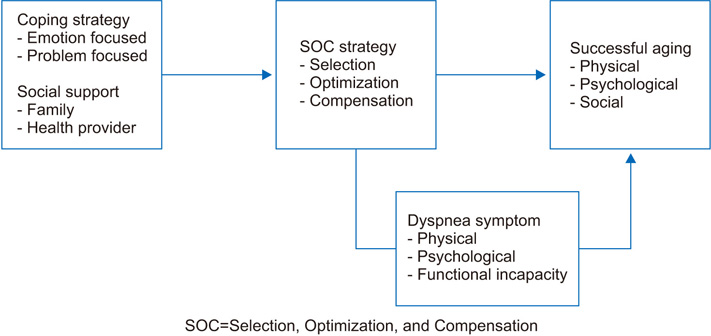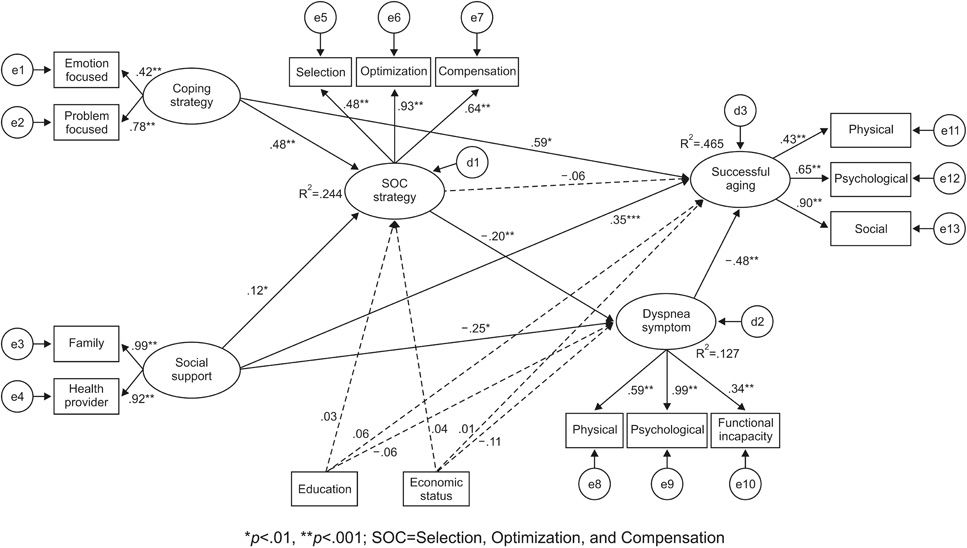J Korean Acad Nurs.
2017 Aug;47(4):488-498. 10.4040/jkan.2017.47.4.488.
Structural Equation Modeling on Successful Aging in Elders with Chronic Obstructive Pulmonary Disease Based on Selection-Optimization-Compensation Strategy
- Affiliations
-
- 1Department of Nursing, Daejeon Institute of Science and Technology, Daejeon, Korea.
- 2College of Nursing, Chungnam National University, Daejeon, Korea. songry@cnu.ac.kr
- KMID: 2389025
- DOI: http://doi.org/10.4040/jkan.2017.47.4.488
Abstract
- PURPOSE
The focus of the study was on the selection-optimization-compensation (SOC) strategy to predict successful aging mediated by dyspnea symptoms in older adults with chronic obstructive pulmonary disease. The model was constructed based on the hypotheses that coping strategy and social support of the elders predict successful aging through the SOC strategies.
METHODS
Participants were 218 outpatients with chronic obstructive pulmonary disease recruited for the study. Data collection was done from March 25 to September 11, 2015, and analyzed using SPSSWIN 22.0 and AMOS 21.0.
RESULTS
The hypothetical model appeared to be fit to the data. Seven of eight hypotheses selected for hypothetical model were statistically significant. The SOC strategy has only significant indirect effects through dyspnea symptoms on successful aging. Coping strategy, social support, SOC strategies and dyspnea symptoms explained 62% of variance in successful aging.
CONCLUSION
The SOC strategies with social support and dyspnea symptoms significantly explained successful aging among patients with chronic obstructive pulmonary disease. Nursing strategies should be focused on social support and coping strategies to optimize SOC strategies so that older adults with chronic obstructive pulmonary disease are able to manage dyspnea symptoms and eventually achieve successful aging.
MeSH Terms
Figure
Cited by 1 articles
-
Development of a scale to measure selection, optimization, compensation (SOC) strategy in late middle-aged women: a methodological study
Do-Young Lee, Gie Ok Noh
Womens Health Nurs. 2024;30(3):216-225. doi: 10.4069/whn.2024.08.10.
Reference
-
1. Statistics Korea. Aging index [Internet]. Daejeon: Author;2016. cited 2016 November 15. Available from: http://kosis.kr/statHtml/statHtml.do?orgId=101&tblId=DT_2KAA202&conn_path=I2.2. Rowe JW, Kahn RL. Human aging: Usual and successful. Science. 1987; 237(4811):143–149. DOI: 10.1126/science.3299702.3. Rowe JW, Kahn RL. Successful aging 20: Conceptual expansions for the 21st century. J Gerontol B Psychol Sci Soc Sci. 2015; 70(4):593–596. DOI: 10.1093/geronb/gbv025.4. Rowe JW, Kahn RL. Successful aging. Gerontologist. 1997; 37(4):433–440. DOI: 10.1093/geront/37.4.433.5. Lee SJ, Song M. Successful aging of Korean older adults based on Rowe and Kahn's model: A comparative study according to the use of community senior facilities. J Korean Acad Nurs. 2015; 45(2):231–239. DOI: 10.4040/jkan.2015.45.2.231.6. McLaughlin SJ, Connell CM, Heeringa SG, Li LW, Roberts JS. Successful aging in the United States: Prevalence estimates from a national sample of older adults. J Gerontol B Psychol Sci Soc Sci. 2010; 65B(2):216–226. DOI: 10.1093/geronb/gbp101.7. Han S, Yun SN. Successful aging and the influencing factors in the Korean elderly: Focused on family support. J Korean Acad Community Health Nurs. 2015; 26(4):372–379. DOI: 10.12799/jkachn.2015.26.4.372.8. Jeong YH, Ko SJ, Kim EJ. A study on the effective chronic disease management. Seoul: Korea Institute for Health and Social Affairs;2013. Report No.: Research Report 2013-31-19.9. Celli BR, Decramer M, Wedzicha JA, Wilson KC, Agusti A, Criner GJ, et al. An official American Thoracic Society/European Respiratory Society Statement: Research questions in chronic obstructive pulmonary disease. Am J Respir Crit Care Med. 2015; 191(7):e4–e27. DOI: 10.1164/rccm.201501-0044ST.10. Jang JH, Ryu SD, Kim HS, Lee KM, Jung SP. Association between physical activity and hypertension in chronic obstructive pulmonary disease. Korean J Health Promot. 2016; 16(2):77–83. DOI: 10.15384/kjhp.2016.16.2.77.11. Ouwehand C, de Ridder DT, Bensing JM. A review of successful aging models: Proposing proactive coping as an important additional strategy. Clin Psychol Rev. 2007; 27(8):873–884. DOI: 10.1016/j.cpr.2006.11.003.12. Freund AM, Baltes PB. Selection, optimization, and compensation as strategies of life management: Correlations with subjective indicators of successful aging. Psychol Aging. 1998; 13(4):531–543. DOI: 10.1037/0882-7974.13.4.531.13. Solomon R, Peterson M. Successful aging: How to help your patients cope with change. Geriatrics. 1994; 49(4):41–47.14. Oh DN. Structural equation modeling on successful aging in elders: Focused on selection, optimization, compensation strategy. J Korean Acad Nurs. 2012; 42(3):311–321. DOI: 10.4040/jkan.2012.42.3.311.15. Young Y, Frick KD, Phelan EA. Can successful aging and chronic illness coexist in the same individual? A multidimensional concept of successful aging. J Am Med Dir Assoc. 2009; 10(2):87–92. DOI: 10.1016/j.jamda.2008.11.003.16. Donnellan C, O'Neill D. Baltes' SOC model of successful ageing as a potential framework for stroke rehabilitation. Disabil Rehabil. 2014; 36(5):424–429. DOI: 10.3109/09638288.2013.793412.17. Gignac MA, Cott C, Badley EM. Adaptation to disability: Applying selective optimization with compensation to the behaviors of older adults with osteoarthritis. Psychol Aging. 2002; 17(3):520–524. DOI: 10.1037/0882-7974.17.3.520.18. O'Donnell DE, Banzett RB, Carrieri-Kohlman V, Casaburi R, Davenport PW, Gandevia SC, et al. Pathophysiology of dyspnea in chronic obstructive pulmonary disease: A roundtable. Proc Am Thorac Soc. 2007; 4(2):145–168. DOI: 10.1513/pats.200611-159CC.19. Bae BR. Structural equation modeling with Amos 19: Principles and practice. Seoul: CRBooks;2011.20. Jalowiec A, Murphy SP, Powers MJ. Psychometric assessment of the Jalowiec Coping Scale. Nurs Res. 1984; 33(3):157–161. DOI: 10.1097/00006199-198405000-00008.21. Tae YS, Kang ES, Lee MH, Park GJ. The relationship among perceived social support. hope and quality of life of cancer patients. Korean J Rehabil Nurs. 2001; 4(2):219–231.22. Baltes PB, Baltes MM, Freund AM, Lang F. The measurement of selection, optimization, and compensation (SOC) by self report: Technical report. Berlin, DE: Max-Planck-Institut für Bildungsforschung;1999.23. Kinsman RA, Yaroush RA, Fernandez E, Dirks JF, Schocket M, Fukuhara J. Symptoms and experiences in chronic bronchitis and emphysema. Chest. 1983; 83(5):755–761. DOI: 10.1378/chest.83.5.755.24. Oh EG. Physical, psychological symptoms and the degree of dyspnea perception in patients with COPD [master's thesis]. Seoul: Yonsei University;1990. 1–47.25. Stenton C. The MRC breathlessness scale. Occup Med (Lond). 2008; 58(3):226–227. DOI: 10.1093/occmed/kqm162.26. Kim YS. A study on the effects of successful aging in sibling relationship feature at old age [master's thesis]. Seoul: Sungshin Women's University;2006. 1–80.27. Baker CF, Scholz JA. Coping with symptoms of dyspnea in chronic obstructive pulmonary disease. Rehabil Nurs. 2002; 27(2):67–73. DOI: 10.1002/j.2048-7940.2002.tb01987.x.28. Lee SH, Jang HS, Yang YH. The influence of subjective health status, post-traumatic growth, and social support on successful aging in middle-aged women. J Korean Acad Nurs. 2016; 46(5):744–752. DOI: 10.4040/jkan.2016.46.5.744.29. Smith ML, Honoré Goltz H, Ahn S, Dickerson JB, Ory MG. Correlates of chronic disease and patient-provider discussions among middle-aged and older adult males: Implications for successful aging and sexuality. Aging Male. 2012; 15(3):115–123. DOI: 10.3109/13685538.2011.641184.30. Kahana E, Kahana B. Successful aging among people with HIV/ AIDS. J Clin Epidemiol. 2001; 54:Suppl 1. S53–S56. DOI: 10.1016/S0895-4356(01)00447-4.31. Kanervisto M, Saarelainen S, Vasankari T, Jousilahti P, Heistaro S, Heliövaara M, et al. COPD, chronic bronchitis and capacity for day-to-day activities: Negative impact of illness on the health-related quality of life. Chron Respir Dis. 2010; 7(4):207–215. DOI: 10.1177/1479972310368691.
- Full Text Links
- Actions
-
Cited
- CITED
-
- Close
- Share
- Similar articles
-
- Structural Equation Modeling on Successful Aging in Elders: Focused on Selection, Optimization, Compensation Strategy
- Academic burnout and selection-optimization-compensation strategy in medical students
- Recent Advances in Molecular Basis of Lung Aging and Its Associated Diseases
- Clinical use of chest CT in chronic obstructive pulmonary diseases
- Model Setting and Interpretation of Results in Research Using Structural Equation Modeling: A Checklist with Guiding Questions for Reporting



